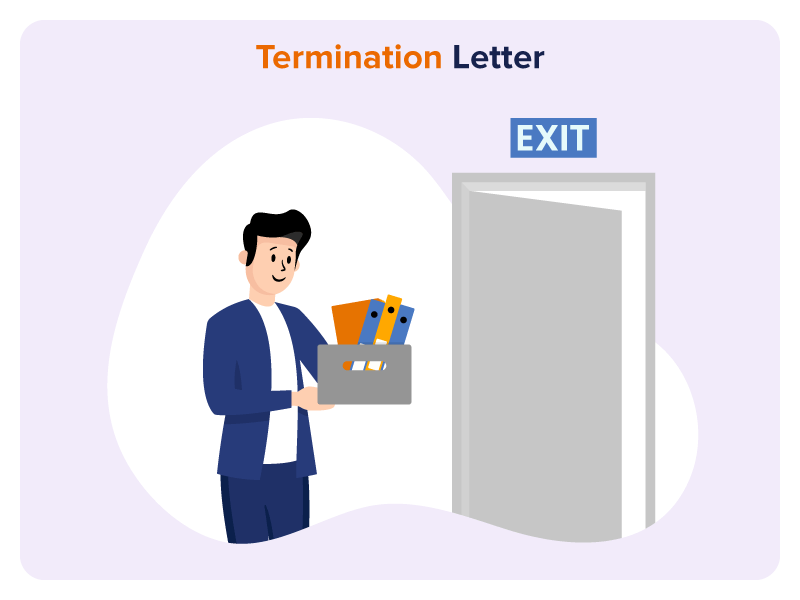
Termination-Letter-main
A manager never wants to receive an ex-offering letter of termination.
In a perfect world, everyone could perform all their responsibilities and duties flawlessly, respond appropriately when confronted with constructive feedback, and remain courteous and professional at work.
But, regardless of how effective your training, disciplining procedures, and time, an employee is likely to behave in a way that leaves you with no choice other than to end their employment.
In other instances, like restructuring or cash flow issues, the decision to end the employment could be a difficult option that isn’t the blame on the worker.
Even though firing employees can be the most difficult job an administrator has to complete during their tenure, it’s essential to be prepared for scenarios.
A boilerplate termination letter and a watertight procedure for terminating employment mean these situations can be dealt with quickly and easily.
Furthermore, having the procedure and the letter endorsed by all the stakeholders and thoroughly reviewed by your legal department will put you and the business in a far better legal position should the employee concerned argue against their dismissal.
What is a Termination Letter?
An employee’s termination note is the form used to inform (or, in some instances) the employee that their employment contract is about to be terminated.
Based on the circumstances depending on the situation, the termination letter could constitute the initial time that the employee is told how their contract will be ending.
In most instances, the letter will be handed out during a meeting, where the issue is discussed in writing. In this scenario, the letter formally acknowledges the information and guarantees that everyone has an official record of the decision to terminate and the reasons or reasons for the decision.
The reasons could vary from behavioral and performance issues to the business’s restructuring or financial matters. Whatever the reason they are, it is essential to mention these reasons when writing the company’s letter.
How to Write a Termination Letter
When writing a termination letter, It is essential to follow the guidelines cautiously. Remember that the document can be used in court should the employee file a lawsuit.
The first thing to do is keep the tone of the letter formal. Although it may seem like an unusual tone to choose in the case of, say, the culture of your business is extremely casual, and your interaction with the employee you are addressing is always simple, It is the perfect occasion to be formal.
In addition, maintaining a professional tone aid in making sure you do not write anything that could be a legal hindrance and lets the employee know that this isn’t an action that’s been made lightly and is being handled with the rigor it deserves.
This may seem simple, but the truth can’t be overstated. Write the letter in a manner that clearly states that the employee’s job has been removed. There should be no room for ambiguity in any way.
In addition, the specifics about the reason(s) that the employee’s employment was terminated must be written chronologically, with information such as dates and dates. Although you might want to be brief, it’s more crucial to provide all details rather than gather all the information in one place.
Most of the time, the most effective way to proceed following the termination letter would be to ensure that the employee stays as far away from the company as possible. That said, it’s essential to include all the relevant details the employee requires to know about their dismissals, such as how to retrieve their belongings from their office or the best way to return their work permit.
It is also important to mention any disciplinary action previously taken against the employee. This could include verbal warnings, written warnings, and suspensions. It is equally crucial to keep track of the specifics of these disciplinary actions and outline the consequences.
End the letter with an end sentence that clarifies that the choice is bad and also a last alternative.
What to Include in a Termination Letter + Tips
Although termination letters can differ by different circumstances, they should generally include the following details:
Your name, your company’s name, email address, and other contact details
- The notice of the termination
- The date on which the termination occurs
- The reasons behind the termination
- The parties of any disciplinary procedures in connection with the suspension
- The information that is relevant to the remaining tasks of the company, for example, handing in key fobs or other required handovers.
Information on any benefits or other compensation they may be entitled to
A mildly sympathetic closing phrase
After you’ve completed the letter, make sure you obtain the signature of everyone that is affected. In addition, it’s important to review the document with those on your legal staff. This can help ensure your protection in the event of legal action and help you feel more secure when dealing with the situation if your employee should respond badly.





